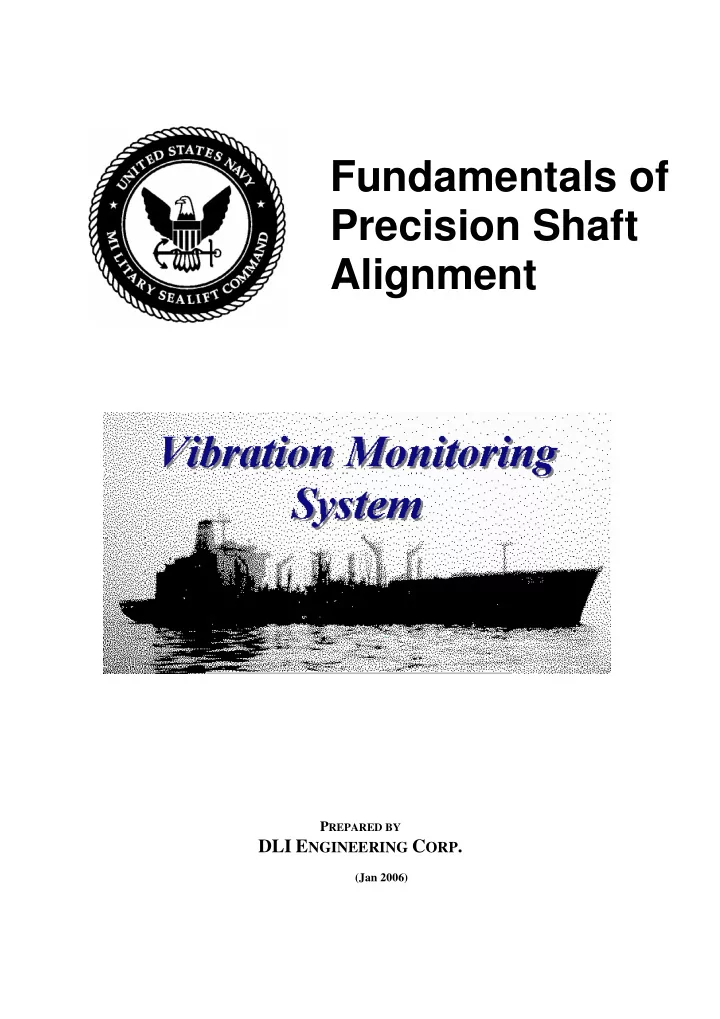

Fundamentals of Precision Shaft Alignment P REPARED BY DLI E NGINEERING C ORP . (Jan 2006)
2
TABLE OF CONTENTS Preface and Table of Contents .........................................................................................i List of Figures and Tables................................................................................................ii Safety Precautions............................................................................................................iii Glossary ...........................................................................................................................vi 1. Introduction To Alignment ........................................................................................1 1.1 Overview........................................................................................................1 1.2 Basic Concepts...............................................................................................1 1.3 Causes And Corrections Of Misalignment ....................................................3 1.4 Section 1 Quiz................................................................................................8 2. Pre-Alignment Procedures.........................................................................................9 2.1 Outline............................................................................................................9 2.2 Trial And Error Alignment Method...............................................................9 2.3 Dial Indicator Method ...................................................................................10 2.4 Section 2 Quiz................................................................................................15 3. Measurements And Calculations ...............................................................................16 3.1 Outline............................................................................................................16 3.2 Three Methods ...............................................................................................16 3.3 Section 3 Quiz................................................................................................21 4. Horizontal Machinery Alignment ..............................................................................22 4.1 Outline............................................................................................................22 4.2 Alignment Procedures....................................................................................22 4.3 Section 4 Quiz................................................................................................28 5. Vertical Machinery Alignment ..................................................................................29 5.1 Outline............................................................................................................29 5.2 Alignment Procedure .....................................................................................29 5.3 Section 5 Quiz................................................................................................36 6. Supplemental Information..........................................................................................37 6.1 Rim & Face Method Of Alignment ...............................................................37 6.2 Case of Obstruction........................................................................................39 Workbook and Lecture Guide..........................................................................................41
LIST OF FIGURES AND TABLES Figure 1-1, Parallel and angular misalignment..................................................................2 Table 1-1, Alignment Tolerances.....................................................................................2 Figure 1-2, Coupling alignment.........................................................................................3 Figure 1-3, Assembly of Indicator reverse method. ..........................................................4 Figure 1-4, Dial indicator placements. ..............................................................................5 Figure 1-5, Indicator Sag...................................................................................................6 Figure 1-6, Soft foot ..........................................................................................................6 Figure 1-7, Thermal growth curve.....................................................................................7 Figure 2-1, Effect of end play on indicator placement. .....................................................11 Figure 2-2, Indicator placement for soft foot check. .........................................................12 Figure 2-3, Indicator setup for checking sag. ....................................................................13 Figure 3-1, Measurements needed for alignment. .............................................................16 Table 3-1, Alignment Formulas ........................................................................................17 Figure 3-2, Graphing the alignment. .................................................................................18 Figure 3-3, Graphical representation of adjustments.........................................................19 Figure 3-4, Dial indicator placement for horizontal movement. .......................................26 Figure 5-1, Dial indicator setup for checking alignment...................................................29 Figure 5-2, Dial indicator setup for correcting alignment ................................................29 Figure 5-3, Measurements for alignment check. ...............................................................30 Figure 5-4, Dial indicator placement for measuring bent flange......................................32 Figure 5-5, Numbering the hold down bolts.....................................................................33 Figure 5-6, Indicator placement for offset adjustment. .....................................................35 Figure 6-1, Setup for rim face method of alignment. ........................................................37 Figure 6-2, Measurements for rim face method. ..............................................................39 ii
PREFACE This manual began as a set of paper copy notes at DLI Engineering. The original author is unknown. SAFETY PRECAUTIONS Machinery alignment is often accomplished in areas that are hazardous, unless proper precautions are observed. Equipment and materials used must be appropriate to the work area and handled correctly to ensure safety of personnel. Constant vigilance by both workers and supervisors is necessary to eliminate hazardous conditions that could cause a fatal or injurious accident. 1. Ensure that neck chains and loose bracelets are removed or properly secured when working with rotating machinery or in close quarters. 2. Ensure that loose clothing is properly secured when working near rotating machinery. 3. Ensure that appropriate protective items, such as gloves, eye shields, and safety shoes are worn to prevent injury. 4. Ensure that all sources of electrical power have been secured and tagged by qualified electricians before undertaking any repairs. 5. Never bypass any electrical safety or control equipment. When it is necessary that a bypass be made for a specific test or check, only qualified electricians should conduct the test or check. Upon completion of test or check, the safety or control device must be restored immediately. iii
GLOSSARY Alignment The process of adjusting a piece of machinery so that its shaft centerline will be in line with the shaft centerline of the machine to which it is coupled. Angularity Is the angle of the shaft centerline of the machine to be moved (MTBM) in relation to the shaft centerline of the Stationary Machine (SM). The angle amount is expressed in rise over run (Thousandths of an inch per inch), rather than in degrees. Back Feet Machine supports opposite the coupled end. Sometimes these are referred to as the free end or as the outboard feet. Cold Alignment This is intentional angularity and offset misalignment entered into the machine to be shimmed, during the cold alignment check, to compensate for thermal growth. Always establish and verify a "Corrected Cold Alignment Specification". Cold Alignment Specification Some manufacturers provide a cold alignment setting that allows the alignment engineer to know how thermal growth will affect the final running alignment. The manufacturer's technical manual should be consulted to obtain this setting. Face Reading Readings obtained with a dial indicator as both shafts are rotated when the centerline of the dial indicator stem is set parallel to the shaft centerline. Front Feet The machine supports on the coupled end, also known as the driven end or inboard feet. Horizontal Misalignment Misalignment which requires horizontal movement of the machine to be moved (MTBM) for correction. Shims are not typically used to correct horizontal misalignment. Hot Alignment Check The act of measuring shaft alignment after the machinery has been operated for a period sufficient to allow it to attain its normal operation temperature and therefore undergo thermal growth. This check should be performed as soon as possible after securing the unit. iv
Recommend
More recommend